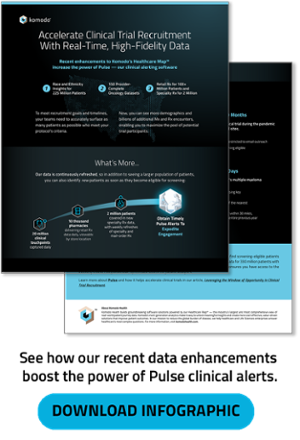The Impact of Inclusion/Exclusion Criteria on Clinical Trial Diversity

 In the past several years, the Life Sciences industry has evolved from having an awareness of the racial and ethnic imbalance in clinical trials to understanding its consequences. With recent data enhancements to Komodo’s Healthcare Map™ — including race and ethnicity (R&E) demographics for ~225 million patients — Clinical Development teams now have the tools needed to begin correcting the problem. The pragmatic question for many is: “How, and where, do we begin to make improvements?”
In the past several years, the Life Sciences industry has evolved from having an awareness of the racial and ethnic imbalance in clinical trials to understanding its consequences. With recent data enhancements to Komodo’s Healthcare Map™ — including race and ethnicity (R&E) demographics for ~225 million patients — Clinical Development teams now have the tools needed to begin correcting the problem. The pragmatic question for many is: “How, and where, do we begin to make improvements?”
Rethinking Traditional Processes
One of the components that shapes patient recruitment is the use of inclusion/exclusion (I/E) criteria. Unfortunately, traditional I/E criteria is often inherently restrictive and automatically stymies efforts to surface the patients being sought. For example, a pharmaceutical company may exclude a diagnosis under an incorrect assumption that it will automatically evolve to a correlated comorbidity. If that diagnosis is more prevalent in non-White vs. White populations, the criterion will quickly (and perhaps significantly) shrink the size of those subpopulations. In turn, the company will likely struggle to recruit a cohort that mirrors the disease’s impact across demographics.
To demonstrate this phenomenon, we recently evaluated I/E criteria used in clinical trial research for diabetic macular edema (DME), which is the most common cause of vision loss in those diagnosed with diabetic retinopathy (DR). DR is the leading cause of blindness in American adults under the age of 65 and disproportionately impacts Black Americans. Among those diagnosed with DME, Black patients represent 38.3% and White patients represent 44.6% of the population. A recent review of 25 DME/DR clinical trials revealed that, although White patients comprise less than half of the DME target population, they represented ~70% (NIH-sponsored) to ~80% (industry-sponsored) of trial participants. Conversely, Black patients were significantly underrepresented, comprising only ~9% (industry-sponsored) to ~13% (NIH) of participants¹.
.png?width=897&name=Percent%20of%20DME%20(2).png)
Komodo randomly pulled I/E criteria from one of the 25 trials and used our Healthcare Map to model its impact on demographics. We discovered that the I/E criteria boosted the pool of potential White participants by 9% while depressing the pool of potential Black participants by 23%, which illustrates how a bias to the status quo can impact recruitment. Fortunately, organizations can model I/E criteria to identify which criterion is having the most disproportionate impact on screening-eligible patients and adjust it, increasing patient representation by 1.5-2x. And, even if the I/E criteria cannot be changed/adjusted, being aware of its impact enables you to proactively compensate for it. For example, you can view the patient journeys of target subpopulation(s) to facilitate successful recruitment, such as identifying the hospital(s) treating the greatest volume of the subgroup and/or defining the best intervention points; e.g., four days post-DME diagnosis vs. two weeks post-treatment “A.”
It's Not Just About the Data, It’s What You Do With It
Gaining access to R&E insights is only the first step to increasing diversity in clinical trials. Clinical Development teams must learn how to leverage those insights, challenge ingrained assumptions, and revamp processes that perpetuate traditional outcomes. Interrogating I/E criteria is a good place to start. By modeling its impact on the size and makeup of the target population, you can then make adjustments and leverage R&E insights to drive PI and site selection, ensuring your recruitment reflects disease burden. Only then will you be able to achieve patient representation in your trial and measure treatment outcomes by race.
The lack of racial and ethnic representation in clinical trials over many decades will continue to impact patients for years to come. However, if all industry stakeholders work together, we can turn the tide on this issue and ensure healthcare in the future has fewer disparities in care.
Learn more about how Komodo Health is doing its part by helping Life Sciences organizations optimize cohort creation and PI and site selection, and let us know if you’d like to connect.
About the author: Kwame leads Komodo’s efforts to ensure customers maximize real-world evidence and advanced technology to optimize and accelerate clinical development. Prior to Komodo, he most recently spent 13 years at Genentech. Kwame has an MBA from the University of California, Berkeley, and a BS from Stanford University.
To see more articles like this, follow Komodo Health on Twitter, LinkedIn, or YouTube, and visit Insights on our website.
¹Race and ethnic representation among clinical trials for diabetic retinopathy and diabetic macular edema within the United States: A review. Journal of the National Medical Association, ScienceDirect, April 2022.







